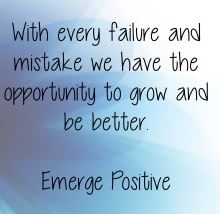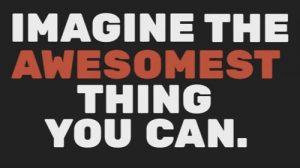Image courtesy of Emerge Positive
Taking a webpage out of Seth Godin’s blog, I have decided that this is going to be a SHORT post (because the last post just might have been way too long…) #failfastrecoverfaster;result=growth with hopefully a decently long reach…
(Link above is to one Leigh Epsy’s posts on her site Project Bliss called “Embrace Failure on the Path to Growth” but my own personally developed hashtag <insert winky face here!>.)
This morning @tcatallo and I hosted another whole-group PD session for the staff at Villanova. Our goal for where we head with PD this year revolves around 2 main focus points:
- Departmental/Subject Area Action Plans
- Meaningful Staff PD Sessions (rooted in feedback from last years survey)
Today’s session was a change of a pace; a step back from the awesome action plan development that the faculty have been fostering and developing so far this year. We decided as a PD Committee to look at the bookends of our classes–the first 5 minutes and the last 5 minutes of class, with the meat being an activity about learning styles through the lens of VARK (Visual/Auditory/Reading&Writing/Kinesthetic). Leading by example, we did activities for the first and last 5 minutes of our 45min session that would hopefully spark both innovation and reflection among our faculty.
Can you guess the opening activity? If you were at the 2nd F2F last weekend, you definitely can! We had our whole staff play Four Corners, borrowing heavily on the Cohort21 exemplar, and asked our faculty to consider a couple of conversation starters, then delve into both our new learning management platform (Edsby) and our classic report card system (Maplewood). It was really interesting to see the groupings and where people felt comfortable moving to–but my favourite moment of the activity was when we asked our staff “Who would feel comfortable coaching someone on how to use Edsby’s Gradebook?” This question was a direct spin-off of this past weekend’s question about who would feel comfortable hosting a Google Hangout. It was great to see teachers conversing about what it means to coach/teach vs. just knowing how to do it yourself or being able to learn it from someone else (and a great discussion among staff ensued during this part of the activity!).
We then had a final question that we used to sort teachers into learning styles (Visual, Auditory, Reading/Writing, or Kinesthetic). We asked them “If you were teaching students about wilderness/nature parks, would you a) take them to the park, b) have a guest speaker, c) give them a pamphlet or d) look at maps of the park” and then based upon the corner they picked we sorted them into groups. The idea was to have them identify with their own learning styles and then once in groups we would start the ‘meat’ of our session and have them come up with an activity in the learning style they associate with first (followed by one that put them in their growth zone).
However, we got immediate feedback that many teachers would not have picked the pamphlet option if they knew it was the reading/writing learning style overall. Some told us they picked what they picked because they don’t like being outdoors, but would prefer to teach using a kinesthetic approach for most lesson plans (additionally, over half the phys-ed department was there–it was fascinating)! And clearly it was a mini-fail for us, in the ambiguity or different interpretations of the sorting question. A mistake that we can harness so that we ’emerge positive’ for the next session. 🙂
We still had a great overall response to the morning, and the last five minutes showcased our three new mini-initiatives we plan to have at every meeting from here on forward (which also work well as class-enders):
- Video of the month
- Application of the month
- Blog of the month
In true collaboration style, thanks to everyone (from Cohort21) who has shared these awesome resources (and more!) with me over the past few months!
1. Video – we showed the Rubik’s Cube Google video we saw this past weekend at the F2F
2. App – I talked about Recap (the awesome formative assessment video app @jwood told my group about at the 1st F2F)
3. Blog – you guessed it! Non other than Seth Godin’s blog… seriously, share this guys words with anyone and everyone you can! We looked at one of the many awesome ones!
So although this morning’s session wasn’t perfect – it was fruitful, and overall I believe we, as a school community, are “emerging positive”!
When the session ended, I had an English teacher ask me where they could get the link to Seth’s blog. I then had a discussion with our Middle School French Teacher. She asked when she could book time with me to learn more about Recap. We talked about meeting early next week to get her started on it (FYI – part of my role this year is to be a tech-integration liaison for teachers!). Sweet!
After period 1 I spoke with @smastromonaco who had already tried a handwritten exit ticket. Her response “I know it was only handwritten” was countered by my “cool, it was handwritten! That’s awesome!”
Midday I received an email from @lisapicerno who had already tried Recap and had this to say about it:
Plus: Easy registration
Minus: If the student messes up, they don’t get another chance to re send it
I thought this was really interesting, and I would love to hear from @jwood or @lmcbeth or anyone else from the @cohort21 community who has experience with this app and it’s quirks!
(And another teacher just popped in to tell me that you can set the videos to be 30s, 60s, or 1min!)
So that’s the update. My two take-aways when reflecting upon what I’ve written are:
a) Cohort21ers are Cohort21ers and go-getters for life (everyone who took action at my school after this morning’s PD was a cohortee except for one teacher!)
b) This still isn’t that short, but if you compare it to my previous entry, it’s an improvement- let’s call it a work in progress! 🙂




Great post, Elissa,
When I first started teaching over ten years ago, I asked my mother (also a life-long teacher) if there were any activities she used to engage her classes back in the day. The activity she shared with me was the Four Corners one. Of course, in her day, the prompts were projected on an overhead, but the result is the same— people moving and making real-team decisions. I too found this a powerful way to start a session, and unpack, perhaps, some uncomfortable assumptions about how the class/PD is going. As a fellow PD developer, I too am worried about “initiative fatigue” and teacher “buy-in”. Thanks for illustrating how positive change in a staff can be fostered.
Thanks, Eric! And yes, we are constantly working to assess and improve but-in and engagement in PD. We (@tcatallo & I) also hope it fosters a spillover effect into the classroom setting.
That said, there are definitely some rocks. I can’t remember if it was Garth or Justin who said the phrase to me a couple years ago now, but regardless, it’s a good one and goes something like this: there will always be some rocks. We have to keep flowing past anyway, collecting what we can to carry with us, but not fretting about the really big rocks that are stuck where they are.
P.S. Writing this from my phone which I’ve never done before so sorry if it’s rough to read! I also can’t spellcheck it easily, so that’s good to know for next time!
P.P.S. That’s really cool that your mom used four corners too! I also like the space saving variation that’s linear and has a spectrum (but then it’s useful when there’s a linear spectra of answers – like are you an extravert or an intravert? Thanks for sharing about your experiences and keep me posted about what works best in your neck of the woods!
@egelleny –
Was great to see you on Monday night.
Have you read @ljensen ‘s post about the PD that she planned??
http://cohort21.com/larajensen/2016/11/28/how-i-ditched-my-workshop-slideshow-mostly/
Between the two of you, I’ve really begun to rethink the way that I plan and organize any PD sessions that I lead!
As I slowly get caught up on all of the blog posts that I’ve been behind on, I’m really starting to realize what an amazing day I missed at the 2nd F2F! 🙁
Jen
Haha – the whole time I was reading your post I was struck by your enthusiasm and how simple yet powerful the strategies you employed must have been for teachers since they had multiple layers of meaning (both the content you were discussing as well as how they could be implemented in classrooms). Thanks for the shout-out but I think I’m going to follow your lead with a video, app and blog a month. Love it!
Whoa, this sounds like a great picture of learning in general. Did you talk to your teachers about how this session is the way an actual class can be set up? You were intentional with what you wanted them to get out of the session, there was agency and decision involved, and a reflection at the end too. Nice!
I’d add to this, that you should check out the book “Focus” – it’s a great read about make great classes simple. If, for example, in the English classroom, every students has an opportunity to read, write and discuss, it is a great class…NB EVERY CLASS!
Check it out,
garth.
Awesome! Thanks, Garth! I will check out the book! And yes, we chatted about how this was the way you could set-up a class- it helped that this session was the approximate length of a class too! 🙂
-E